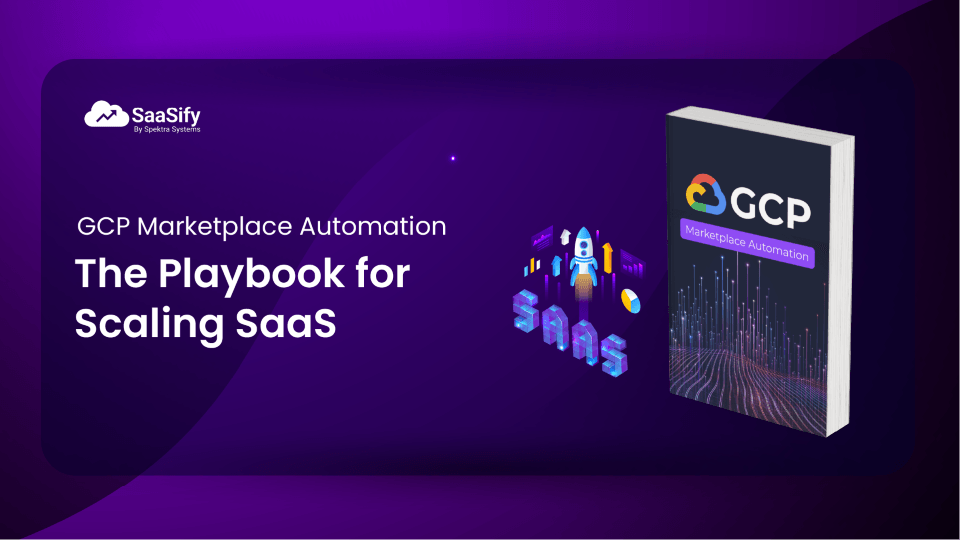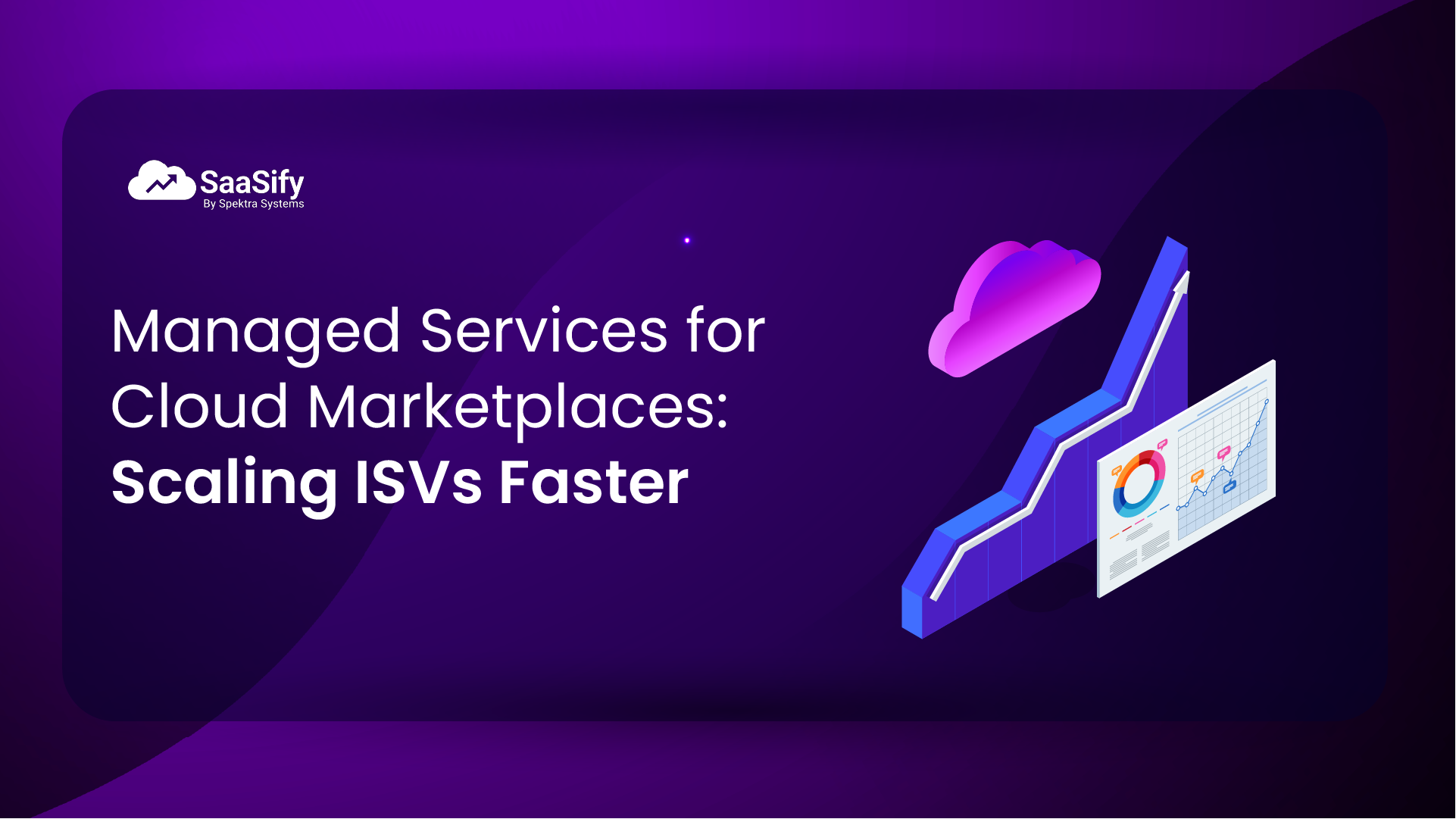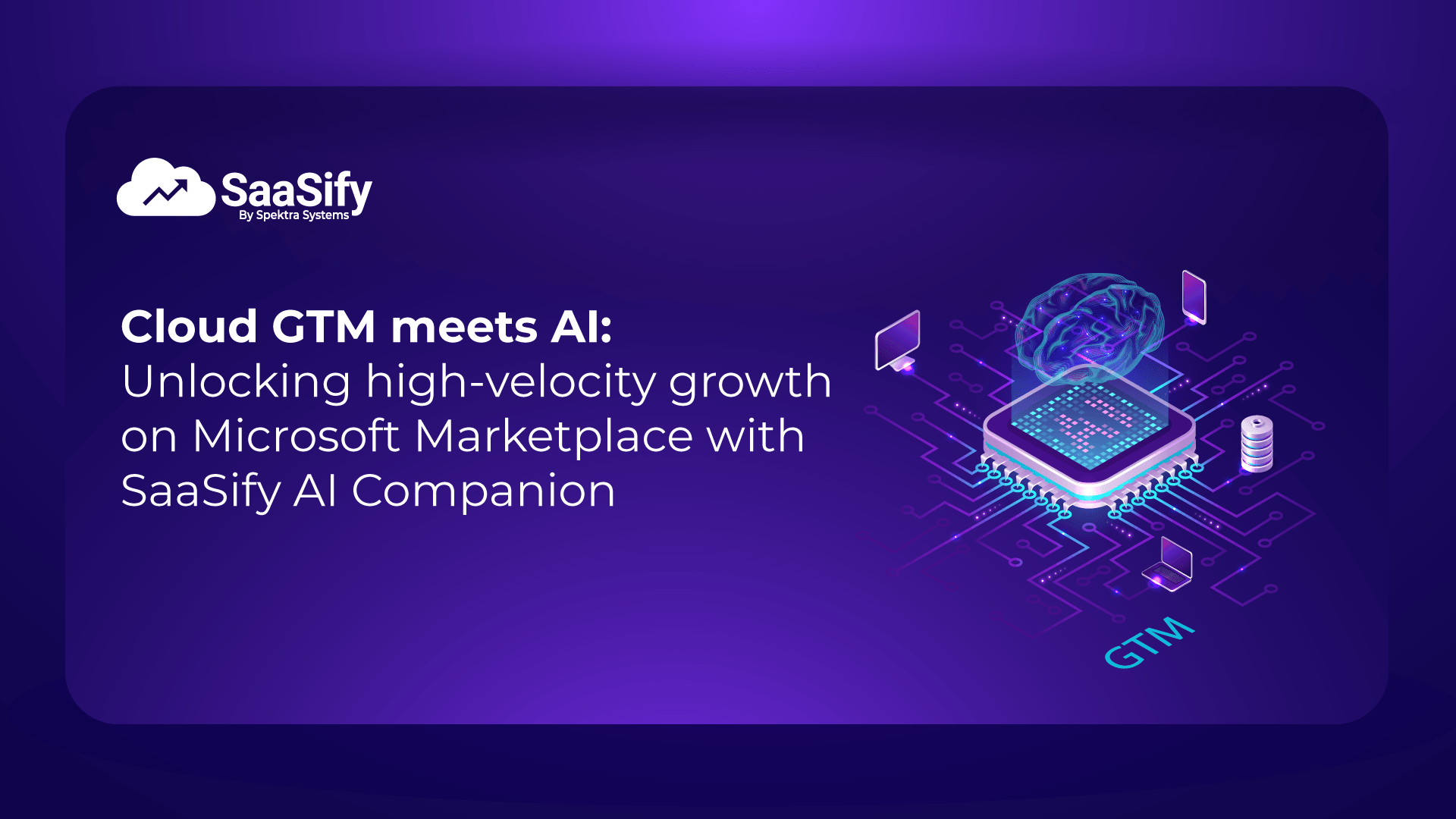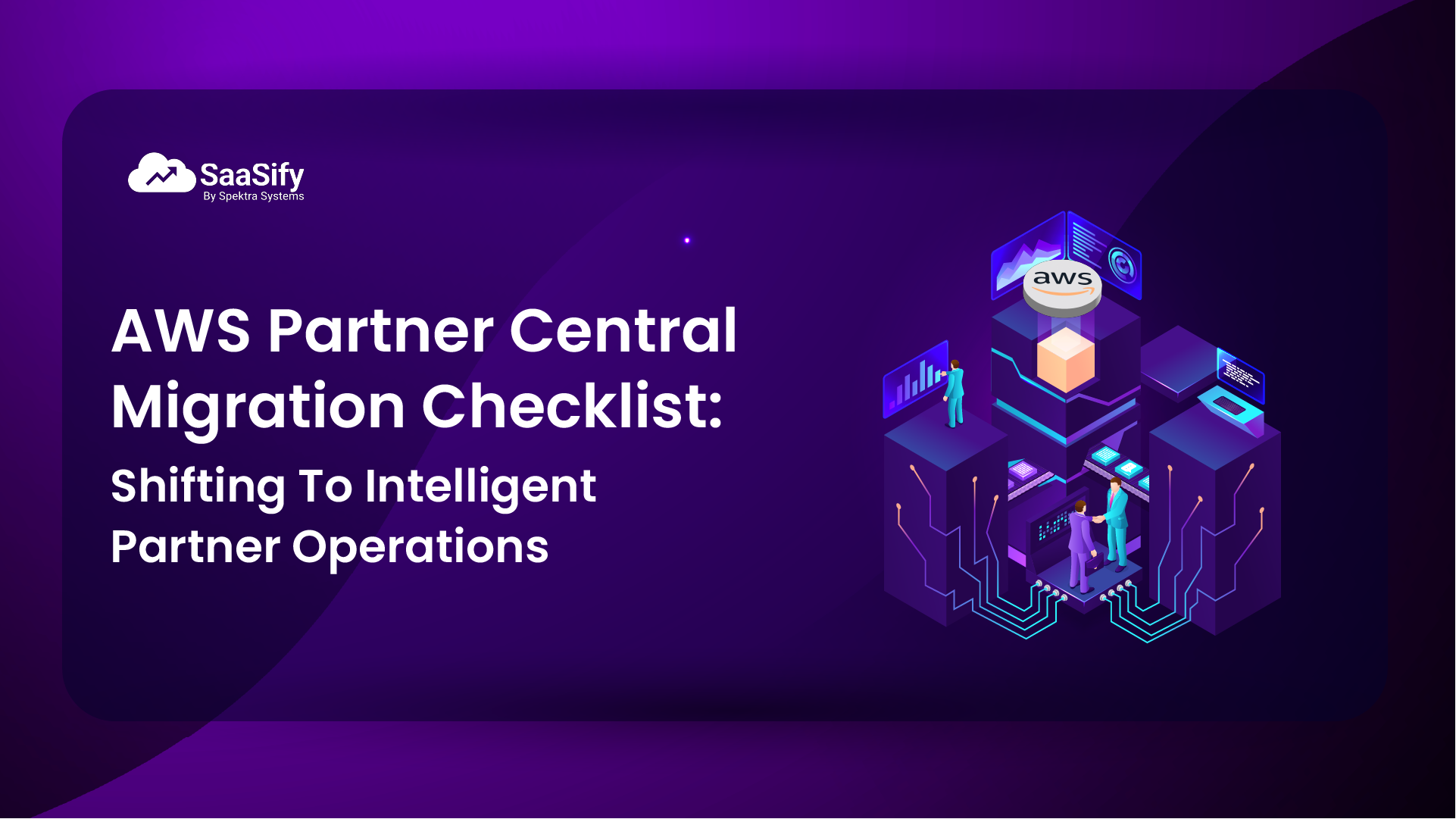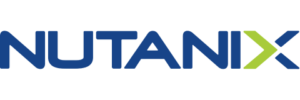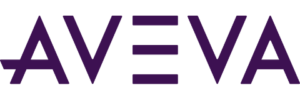From 6% to 12%: How GCP Marketplace is Powering ISV Growth
The rapid growth of Google Cloud Marketplace and the rise of GTM platforms together have opened a stronger and faster path to revenue for GCP ISVs.
GCP’s 12% market share in 2024 is double what it was in 2017. Further, with marketplace analysts projecting cloud marketplace procurement to exceed $85 billion by 2028 (Canalys), this momentum is only accelerating.
For ISVs, this growth wave presents a powerful opportunity to fully capitalize on their SaaS offerings.

But tapping into this opportunity isn’t without challenges. After years of supporting ISVs on cloud marketplaces, we’ve seen many struggle to go live and scale across hyperscalers. Just 20% of ISVs generate 80% of marketplace revenue, while the rest battle fragmented operations, broken co-sell workflows, and limited platform visibility.
This underscores the need to rethink what top performers are doing differently that the rest are missing.
The answer lies in becoming more streamlined and unified.
Today’s ISVs must develop cohesive strategies and consolidate their tech stacks to participate more effectively in the marketplace growth wave.
Enterprise ISVs like Palo Alto Networks, Zscaler, Databricks, and SentinelOne are clear proof points. These companies have leveraged SaaSify’s no-code marketplace integrations and end-to-end offer lifecycle automation to unlock seamless, scalable growth.
And that’s exactly what we’ll explore in this blog-unpacking the power of automation on Google Cloud Marketplace. We’ll dive into:
- Why automation has become a competitive imperative for ISVs on GCP
- How SaaSify streamlines the end-to-end offer lifecycle
- What the platform’s latest enhancements mean for ISVs looking to scale faster, with significantly less friction
To make this your go-to playbook for GCP marketplace automation, let’s begin by unpacking the full scope of the GCP Marketplace offer lifecycle and why mastering it is essential for operational scale.
New to Google Cloud Marketplace? Get your SaaS offer live on GCP in two weeks, without any product engineering change. Read this exclusive guide to get thorough insights.
How to List SaaS Offers on GCP
What is the GCP Marketplace Offer Lifecycle?
The offer lifecycle in Google Cloud Marketplace is how you manage your SaaS product for optimal performance. It covers everything from listing preparation to transaction, fulfillment, updates, and renewal, all within the Google Cloud ecosystem.
Effectively managing this lifecycle means overseeing a continuous sequence of operational tasks that span both technical and go-to-market functions. These include:
- Setting up your Marketplace account and registering as a GCP seller
- Completing technical onboarding to meet compliance and integration standards
- Defining your offer, including pricing, plans, usage metrics, and support terms
- Integrating with GCP’s billing, entitlement, and procurement infrastructure
- Submitting the offer for Marketplace review and approval
- Creating and managing private offers for enterprise buyers
- Enabling co-selling with Google Cloud sales teams
- Developing go-to-market strategies to accelerate deal closure
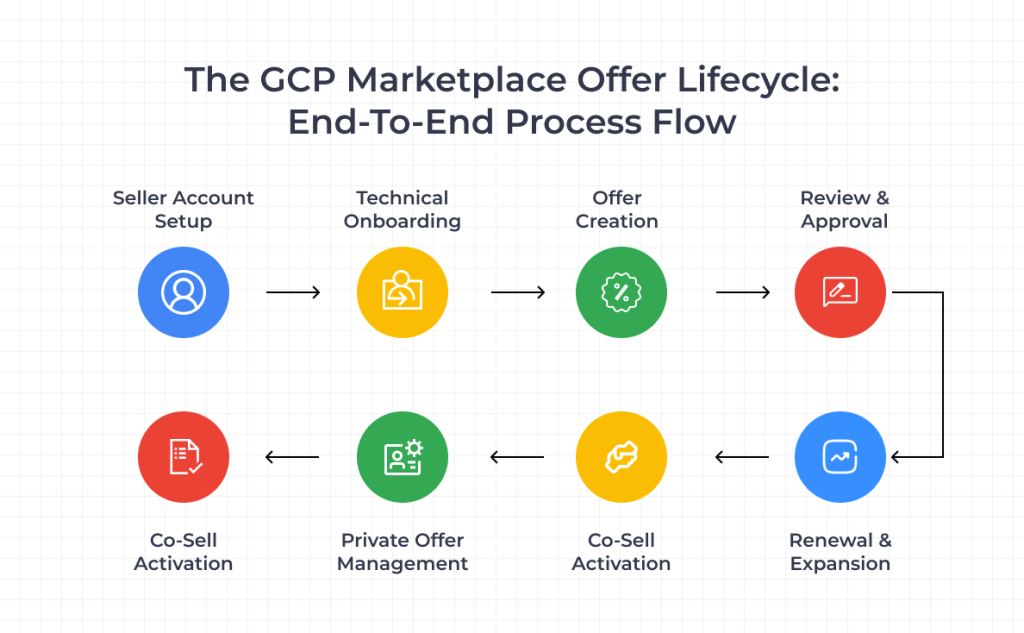
ISVs that understand the intricacies of the Google Cloud Marketplace offer lifecycle and know how to operationalize each step, gain a clear edge over their peers. This advantage leads to faster deal velocity, stronger partnerships with cloud providers, and predictable recurring revenue.
However, achieving operational efficiency across the lifecycle requires both technical fluency and process expertise. As a result, many ISVs end up hiring specialists or building internal teams, which increases overhead without necessarily guaranteeing marketplace success.
That is exactly where SaaSify steps in. Designed to automate and streamline the entire offer lifecycle, SaaSify brings together purpose-built workflows, automation, and GTM intelligence through its no-code GTM platform. It helps ISVs reduce complexity, accelerate execution, and scale strategically across Google Cloud Marketplace. This blog explores how GCP Marketplace Automation helps ISVs simplify complex operations and scale faster.
What Makes GCP Marketplace Automation Critical for ISVs?
To sell successfully through the Google Cloud Marketplace, ISVs need to fulfill the process prerequisites and adhere to its governance norms. While the process is guided, it requires coordinated efforts across various departments in your organization, such as sales, marketing, engineering, and RevOps. A gap in this chain or operational challenges common with the complex GCP workflow often stall progress. This results in delayed time-to-market, resource inefficiencies, and lost revenue due to missed opportunities and duplicated efforts.
Such challenges highlight the critical need for expertise in managing internal coordination and aligning cross-functional teams with marketplace processes. Once your product goes live on the Marketplace, you inherit a new set of operational responsibilities that differ significantly from your traditional go-to-market playbook. And while Google Cloud provides the overarching structure, it’s ultimately up to each ISV to operationalize it effectively.
Let’s explore how these operational responsibilities can challenge different teams across your GTM function.
Complex Onboarding Formalities, Documentation, and Compliance
This initial phase requires close involvement from your Sales and Marketing teams, as well as active support from the technical departments. From technical specifications and product descriptions to pre-marketing materials such as logos, branding assets, and trust-building collateral, every element must align with Google Cloud’s guidelines.
Incomplete or non-compliant submissions often result in rejections during the review phase. ISVs unfamiliar with the marketplace’s documentation standards frequently encounter delays and failed approvals, stalling their onboarding progress.
Engineering heavy API Integrations
Once onboarding is complete, ISVs must fulfill the technical integration requirements to activate their listings. The process encompasses making coding modifications to get their SaaS offer integrated with the Google Cloud Platform.
Most ISVs find this phase resource-intensive and time-consuming, especially those with limited engineering bandwidth. These teams may need to bring in external experts to complete the integration successfully, raising overheads in both the short and long run.
Manual, Error-Prone Billing and Reconciliation
Finance and operations teams play a key role in ensuring accurate billing, revenue recognition, and compliance with the marketplace incentive programs. From setting up metering to reconciling usage reports, the process demands precision, especially with variable billing models and high transaction volumes.
This is hard to achieve with manual processes, and that’s where things often fall apart. ISVs need standardized processes, cross-team alignment, and automation to maintain accuracy, accelerate reconciliation, and avoid revenue leakage.
Slow, Inefficient Private Offer Lifecycle Management
Private offers are crucial for ensuring sustainability in the cloud marketplaces. When leveraged effectively, they can help ISVs tap into multi-million-dollar deals and build predictable, recurring revenue streams.
Enterprise buyers increasingly prefer private offers because they provide custom pricing, buyer-specific terms, and greater deal flexibility. They also help maximize returns on pre-committed cloud spend, making them a win-win for both sellers and buyers.
However, for ISVs, managing the private offer lifecycle involves multiple steps. From configuration and publishing to approvals, renewals, and tracking, the process requires simultaneous inputs from sales, finance, and legal teams.
Without standardized workflows or automation, managing this cross-alignment, both internally and externally, becomes time-consuming and error-prone. The resulting inefficiencies not only delay deal closures but can also lead to lost revenue and strained buyer relationships.
Limited Co-Selling Visibility with Google Cloud Sellers
For ISVs, co-selling presents a powerful opportunity to tap into Google Cloud’s buyer ecosystem -with support from domain experts like Google sellers and channel partners. But to fully leverage these relationships, ISVs need synchronized systems, enabling real-time data sharing between internal CRMs and Google Cloud Partner tools.
Here are some key roadblocks in manual co-sell cycles:
- ISVs often struggle to identify co-sell eligible deals, submit opportunities for approval, and track attribution and progress.
- Slow partner collaboration due to the fragmented systems
- An inefficient co-sell process narrows down your chances of earning incentives and limits joint revenue growth.
- Internal team alignment on closing deals slows down due to the lack of a centralized operational interface, delaying role-based actions and obstructing GTM efficiency.
The SaaSify cloud GTM platform is built to eliminate these bottlenecks. It keeps internal teams and partners aligned on business objectives, empowering them to focus on closing deals instead of navigating platform complexities or adapting to evolving co-sell requirements.
Why GCP Marketplace Automation is Now a Competitive Imperative
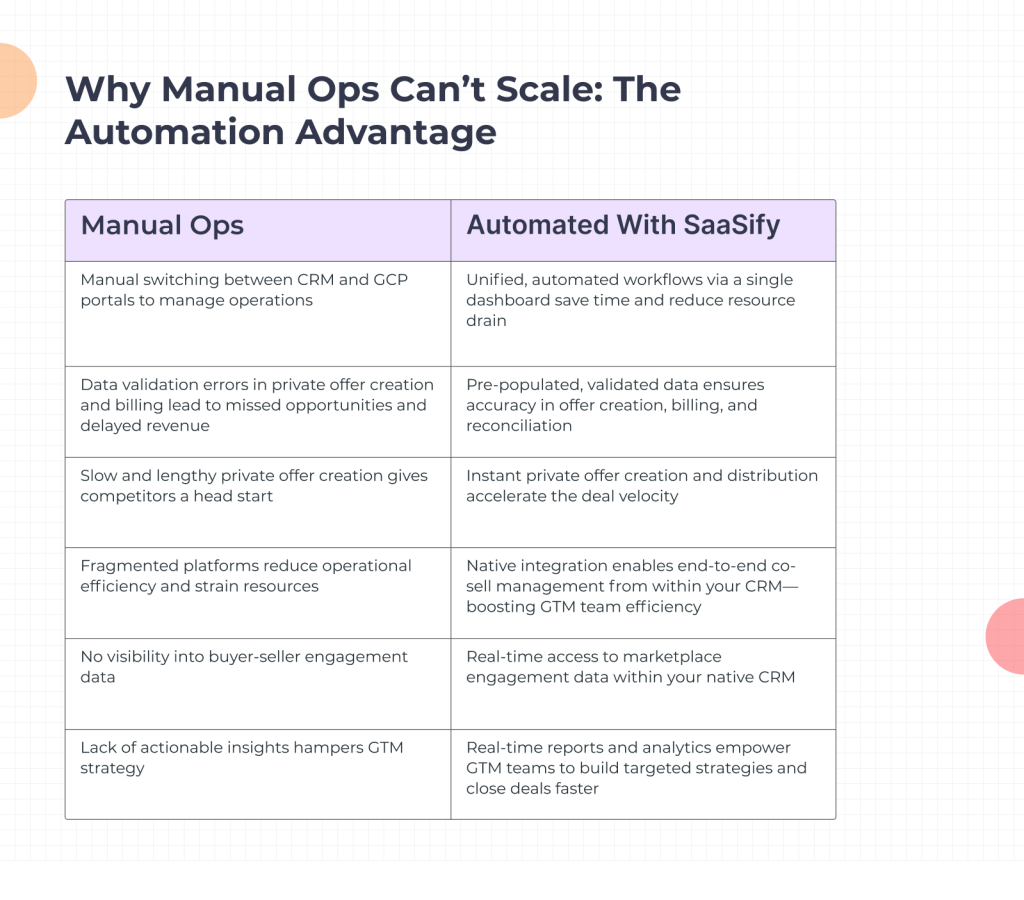
Over 960,000 businesses are procuring SaaS through Google Cloud Marketplace (HG Insights). With such a huge volume, ISV sales teams carry the unsaid responsibility of managing vast amounts of data and complex partner operations, from finding opportunities to closing deals.
On top of that, operational inefficiencies, whether stemming from marketplace limitations or human error, can derail momentum and compromise revenue outcomes.
That’s why automation on hyperscaler platforms is no longer optional; it’s a strategic imperative for scaling. Beyond helping you close deals faster, automation reduces operational costs, streamlines complex workflows, and boosts your team’s overall efficiency.
Here’s how automation simplifies marketplace lifecycle management:
- Standardizes offer lifecycle workflows (onboarding, listing, updates)
- Reduces engineering involvement through no-code configurations
- Enables real-time billing, metering, and reconciliation
- Automates the private offer creation and distribution process
- Integrates your CRM with hyperscaler for seamless co-sell opportunity sync
- Improves accuracy and auditability across revenue operations
Once your marketplace processes are streamlined, here’s how automation translates into real business impact:
1. Enterprise Deals Move Fast
Automation removes friction from SaaS procurement, making the buying process seamless. This results in more successful conversions and fewer missed opportunities. By automating marketplace operations, you create workflows that respond to customer expectations and meet deadlines, without manual intervention.
2. Your Team is Always Operationally Ready
Google Cloud sales teams work on quota, preferring partners who can execute quickly, cleanly, and with minimal risk. With automation, your team aligns more closely with seller intent, making your organization a more dependable, high-performance co-sell partner.
3. Cloud GTM becomes Seamless
Co-selling demands tight coordination, both internally and with partner sellers. Automation brings the entire workflow into one centralized interface, streamlining cross-team actions, boosting accountability, and enabling timely next steps with full transparency.
4. Fewer Errors, Faster Revenue Realization
Billing errors don’t just delay payments; they erode trust. Misreported usage leads to revenue leakage. Incorrect entitlements can slow down onboarding. Incomplete audit logs can affect your standing with hyperscaler partnership programs.
With automation, accuracy improves across billing, metering, and reporting, enabling faster approvals and timely payment realization.
5. A Competitive Edge Over Your Peers
As we’ve seen, the top 20% of ISVs are capturing up to 80% of marketplace-driven revenue. What sets them apart? They’ve already adopted automation to build a competitive edge, and it’s time to do the same.
How SaaSify Simplifies GCP Marketplace Automation
As a leading full-stack Cloud GTM automation platform, SaaSify ensures your entire marketplace lifecycle is streamlined. From listing your SaaS offer on GCP to closing deals successfully, automation on GCP eliminates the inefficiencies and bottlenecks in operational management.
With zero repetitive and manual workflows, SaaSify enables GTM teams to utilize their work hours more strategically in building tailored GTM strategies- probably the most essential need for GTM success in the cloud domain.
How do we do it?
Fast-tracked listing with Zero Engineering Change
Getting listed is a resource-intensive and time-consuming task for most ISVs, often stretching the time-to-market to months and increasing your marketplace onboarding cost.
SaaSify ensures you go live in the marketplace within two weeks and scale efficiently, leveraging simplified operations, strategic insights, and co-sell enablement, all without requiring your team to upskill.
We’ve made this possible through no-code integration, enabling your team to manage marketplace operations from a centralized dashboard, without heavy engineering.
The entire interface is built to be intuitive, offering seamless navigation, like a plug-and-play system. Top ISVs have leveraged our pre-configured templates to enhance operational efficiency and accelerate time-to-market.
Seamless Scalability with Automated Operations Management
Managing the offer lifecycle on cloud marketplaces is a continuous process. Staying operationally aligned with evolving marketplace norms and trends requires ongoing effort across teams. This often drains resources and can be taxing at times, stalling growth and creating revenue leakages.
SaaSify ensures your GTM teams have a scalability edge by automating operations such as:
- Listing management on Google Cloud Marketplace
- Billing, reconciliation, and revenue Operations
- Private offer lifecycle management
- Co-sell operations and partner alignment
- Cross-functional alignment through a centralized interface
- Revenue tracking and deal optimization with strategic insights
The best part? ISVs do not need to deploy extra resources to track and meet marketplace policy updates. Our experts ensure your offer lifecycle stays aligned with the latest requirements, without disrupting your operations.
Integrated Billing and Entitlement Orchestration
SaaSify fully integrates with Google Cloud’s billing and entitlement systems, offering a pre-built orchestration layer that connects payment flows, access management, and metered billing data.
As a result, our partner ISVs get pre-integrated setups to offer scalable, usage-based subscriptions, without the hassle of manually tracking usage or handling reconciliation.
Private Offer Automation at Scale
Creating private offers in the Partner Portal is slow and restrictive. SaaSify removes these limitations by enabling:
- One-click creation of private offers from predefined templates
- Workflow automation that routes offer approvals through internal stakeholders
- Easy sharing of offer links with prospects or Cloud AEs
Sales teams can create and send personalized offers within minutes- no more waiting on back-office teams or manual quote assembly. For enterprise-focused ISVs, this dramatically improves deal velocity and removes friction from your quote-to-cash process.
Native CRM-Marketplace Integration for co-sell enablement
For ISVs, co-sell success depends heavily on speed, coordination, and access to reliable data. However, managing co-sell workflows across disconnected systems often creates friction, delays, and missed opportunities.
SaaSify solves this by integrating directly with your CRM, be it Salesforce, HubSpot, or Dynamics 365, so you can manage all your co-sell operations from your native system of record.
With this integration in place, your GTM, sales, and RevOps teams can:
- Direct opportunity inflow into the native CRM
- Access to bidirectionally sync marketplace data within your native system of record
- Enhanced collaboration with partner sellers to scale co-sell efforts under a single experience
- Opportunity to leverage your CRM database to identify and create co-sell opportunities, and send co-sell requests to partner sellers without switching context
- Receive and accept co-sell referrals from cloud partners within the native CRM.
This integration not only reduces manual coordination but also improves seller alignment, enhances deal transparency, and unlocks faster execution of joint opportunities, giving you a powerful edge in driving co-sell revenue at scale.
Marketplace Insights and Renewal Intelligence
Operating across fast-moving marketplace channels requires more than execution. It requires data that informs timing, targeting, and prioritization. That’s exactly what SaaSify delivers.
From a single, centralized dashboard, your GTM, Sales, and RevOps teams gain actionable insights into:
- Real-time deal progress across products and regions, helping you track pipeline health and eliminate blind spots
- Usage trends and metering anomalies to proactively flag underutilization or discrepancies before they impact revenue recognition
- Upcoming renewals and upsell triggers, enabling your teams to take preemptive actions and convert renewals into expansion opportunities
This kind of intelligence enables your GTM teams to:
- Better forecast revenue from marketplace channels
- Align campaigns with renewal cycles
- Maximize customer lifetime value through timely upsells
- Strengthen co-sell relationships by providing pipeline and deal attribution
SaaSify Upgrades Are Here to Help GCP ISVs Gain the Edge
As a major growth enabler of the cloud GTM domain, SaaSify is strategic with operations and offer lifecycle management. Our aim is to be at the forefront of cloud marketplace automation, helping ISVs simplify complex GTM processes and turn fragmented manual workflows into seamless digital motions.
The latest round of upgrades tailored specifically for Google Cloud Platform (GCP), SaaSify is redefining what operational control, co-selling, and partner collaboration can look like for GCP ISVs.
Here is a closer look at what is new and why ISVs running on GCP stand to benefit the most.
80% Reduction in Operational Friction
SaaSify now supports complete RPOP lifecycle management, including offer amendments, wholesale pricing visibility, and real-time tracking from draft to purchase, directly in the WebApp.
Users can cancel/extend offer deadlines and access detailed offer views, audit logs, and pricing insights with improved flexibility and control.
Enhanced GCP Co-sell Experience
With a redesigned mapping interface and audit logging, SaaSify improves how customer success teams manage GCP co-sell workflows.
Co-sell data syncs from Google Partner Hub to SaaSify, Salesforce, and HubSpot, with resync options and visibility into key update fields like creation dates and approval status.
CRM-Embedded Co-sell & Payment Visibility
SaaSify now brings full GCP co-sell opportunity management into HubSpot and Salesforce, allowing users to create, edit, and track partnerships without leaving their CRM.
GCP subscription records now display payment details, improving financial transparency for operations and revenue teams. Private Offer payment data and subscription records can now sync to Salesforce, improving financial transparency and aligning sales and billing systems.
Salesforce Enhancements for RPOP Management
New GCP RPOP modules in Salesforce support static field mapping (e.g., proration, auto-renew, terms type), plus a “Refresh from CRM” feature to ensure data accuracy and real-time updates.
Improved Seller Account & Subscription Controls
SaaSify adds advanced GCP configuration options, educational guidance for org ID setup, and deeper visibility into subscription payment data, pushed directly to Salesforce for streamlined financial operations.
What ISVs Gain with SaaSify on Google Cloud Marketplace
When we say ‘automation,’ we mean enabling the ISVs to modernize and scale their go-to-market operations with measurable efficiency, accuracy, and partner alignment. Here’s what ISVs gain when they adopt SaaSify on Google Cloud Marketplace:
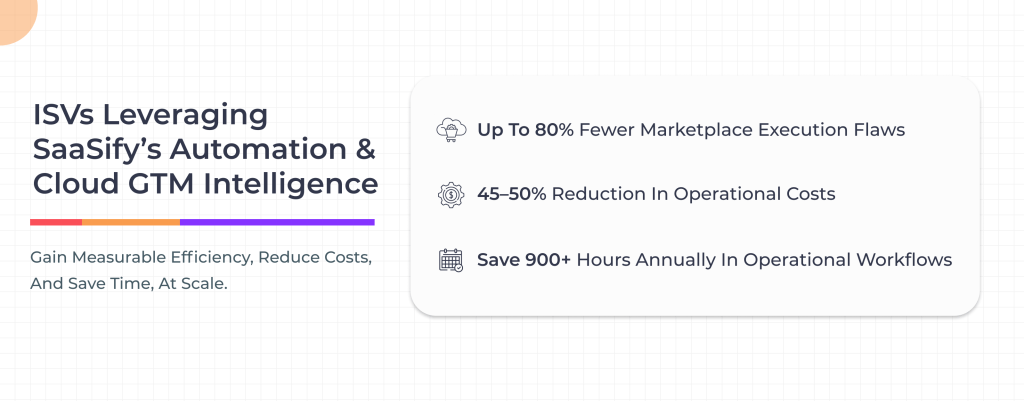
80% Reduction in Operational Friction
With an automated workflow, SaaSify minimizes the operational inefficiencies raised by repetitive workflows, errors, data validations, and context switching. Our GTM platform enables flawless offer creation and communication with GCP partners, with 80% fewer marketplace flaws.
Up to 50% Lower Operational Cost
By automating repetitive marketplace tasks, such as listing updates, billing sync, and offer management, SaaSify reduces the resource burden on engineering, finance, and RevOps. ISVs can scale marketplace operations without scaling headcount.
900+ Hours Saved Annually
ISVs using SaaSify save hundreds of hours that would otherwise be spent coordinating listing changes, provisioning entitlements manually, or updating CRMs post-sale. These efficiencies free up teams to focus on higher-value activities like new offer launches, pricing strategy, and co-sell expansion.
50% Faster Time-to-Deal
SaaSify turns complex private offer creation into a CRM-integrated, near-instant process. Preconfigured workflows, automated approval routing, and real-time CRM sync enable faster turnaround on quotes, accelerating deal cycles in competitive sales environments.
Stronger Cloud Seller Alignment
By ensuring listings are always current, private offers are cleanly executed, and co-sell data syncs with Partner Hub, SaaSify helps ISVs meet the operational standards that GCP partner teams expect, resulting in better co-sell collaboration and increased inclusion in cloud-led account planning.
Improved Renewal and Forecasting Readiness
SaaSify surfaces subscription lifecycle data, usage logs, and entitlement timelines directly in CRM and GTM dashboards. This enables ISVs to proactively engage customers ahead of renewals, reduce churn risk, and forecast recurring revenue with greater accuracy.
Next Step: Explore the Upgrades in Action
Automating marketplace operations on Google Cloud is no longer a future-state goal; it is a current need for ISVs aiming to scale efficiently. As GCP Marketplace automation becomes central to how top ISVs manage listings, offers, billing, and co-sell workflows, manual processes are proving inadequate.
SaaSify addresses this shift directly by embedding GCP Marketplace automation into every stage of the offer lifecycle. From listing and transaction to renewal and expansion, it enables ISVs to reduce overhead, accelerate deal velocity, and maintain operational consistency across teams. The recent platform upgrades further strengthen this alignment, giving GCP-focused ISVs the infrastructure needed to grow with less friction and more precision.
For ISVs looking to turn marketplace potential into measurable outcomes, GCP automation through SaaSify is a proven path forward. If you are one of them, connect with SaaSify experts now! Book a Demo




